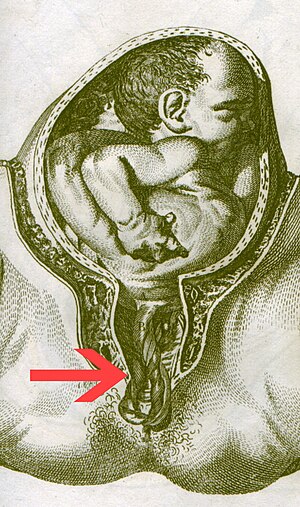Cord prolapse
| Umbilical cord prolapse | |
|---|---|
 |
|
| Cord prolapse, depicted by W.Smellie, 1792 | |
| Classification and external resources | |
| Specialty | pediatrics |
| ICD-10 | O69.0, P02.4 |
| ICD-9-CM | 663.0, 762.4 |
| DiseasesDB | 13522 |
| eMedicine | med/3276 |
Umbilical cord prolapse occurs when the umbilical cord comes out of the uterus with or before the presenting part of the fetus. It is a relatively rare condition and occurs in fewer than 1% of pregnancies. Cord prolapse is more common in women who have had rupture of their amniotic sac. Other risk factors include maternal or fetal factors that prevent the fetus from occupying a normal position in the maternal pelvis, such as abnormal fetal lie, too much amniotic fluid, or a premature or small fetus. The concern with cord prolapse is that pressure on the cord from the fetus will cause cord compression that compromises blood flow to the fetus. Whenever there is a sudden decrease in fetal heart rate or abnormal fetal heart tracing, umbilical cord prolapse should be considered. Due to the possibility for fetal death and other complications, umbilical cord prolapse is considered an obstetric emergency during pregnancy or labor. Current management guidelines focus on quick delivery, which usually entails a cesarean section. With appropriate management, the majority of cases have good neonatal outcomes.
There are three types of umbilical prolapse that can occur:
The first sign of umbilical cord prolapse is usually a sudden decrease in fetal heart rate that is severe and does not immediately resolve. On a fetal heart tracing, this would usually look like moderate to severe . Occasionally, the cord can be seen or felt on vaginal examination, particularly with overt cord prolapse.
Risk factors that are associated with umbilical cord prolapse tend to make it difficult for the fetus from appropriately engaging and filling the maternal pelvis or are related to abnormalities of the umbilical cord. The two major categories of risk factors are spontaneous and iatrogenic, or those that result from medical intervention.
Umbilical cord prolapse should always be considered a possibility when there is a sudden decrease in fetal heart rate or variable decelerations, particularly after the rupture of membranes. With overt prolapses, the diagnosis can be confirmed if the cord can be palpated on vaginal examination. Without overt prolapse, the diagnosis can only be confirmed after a cesarean section, though even then it will not always be evident at time of procedure.
...
Wikipedia
